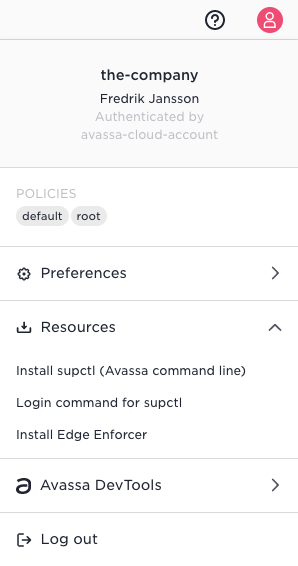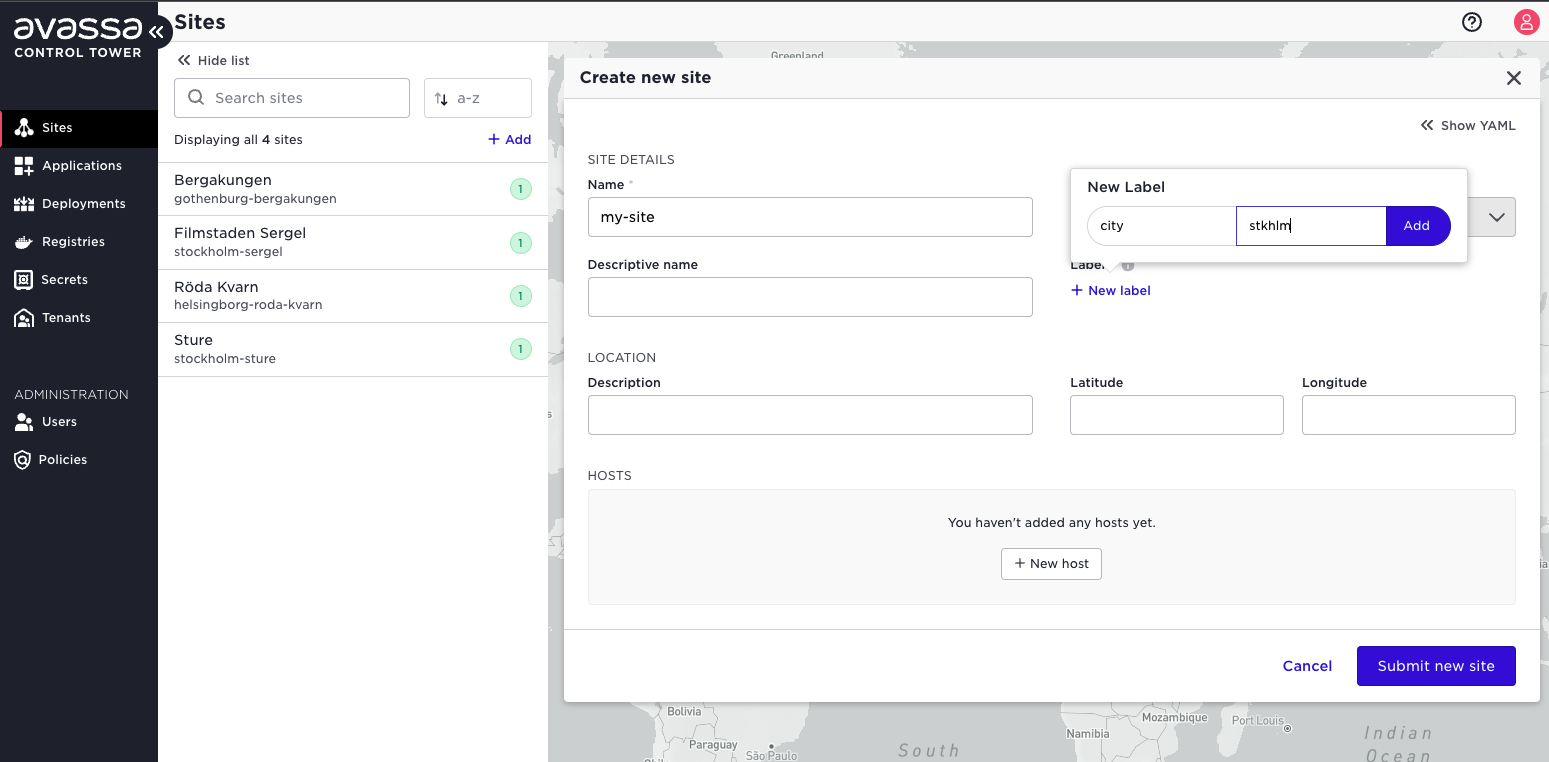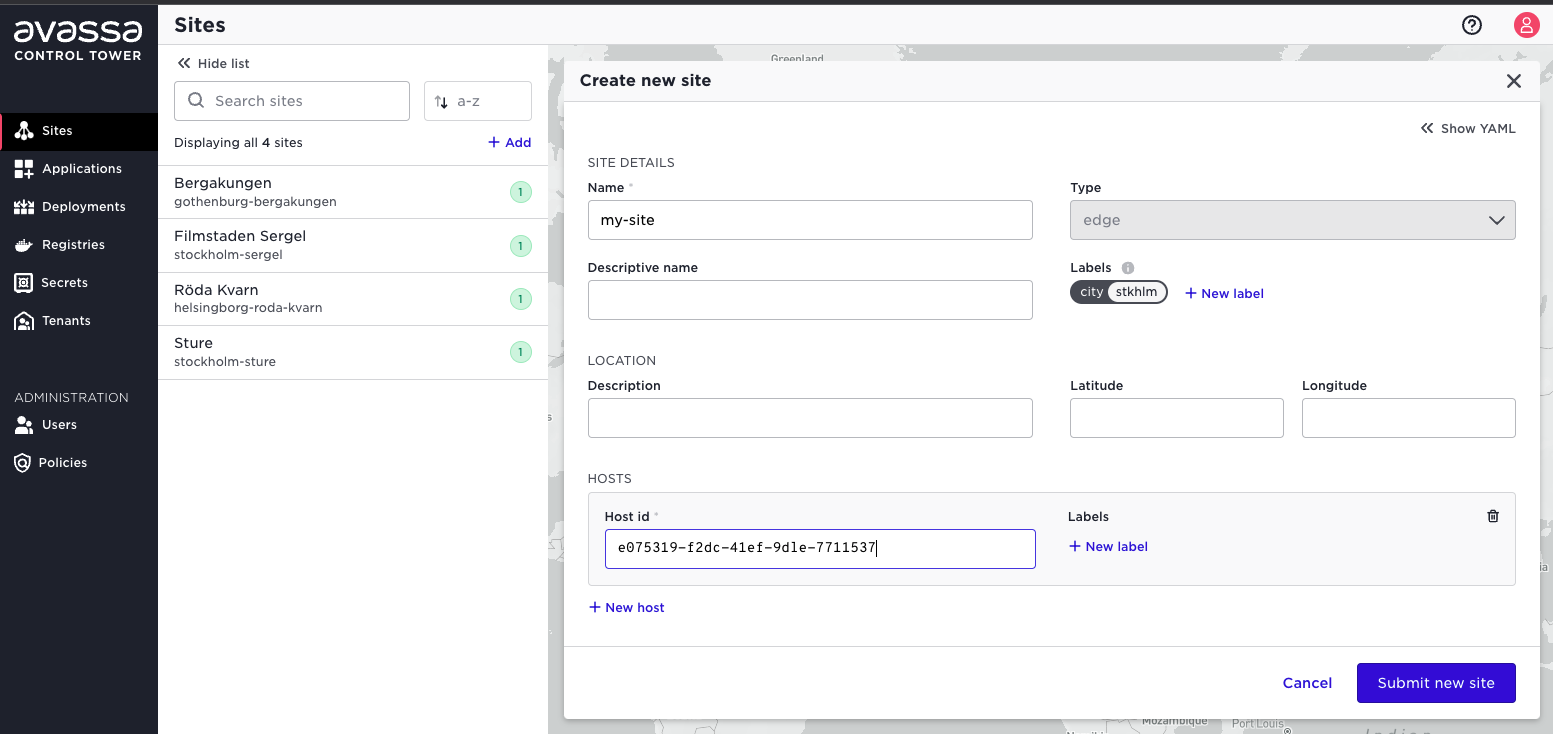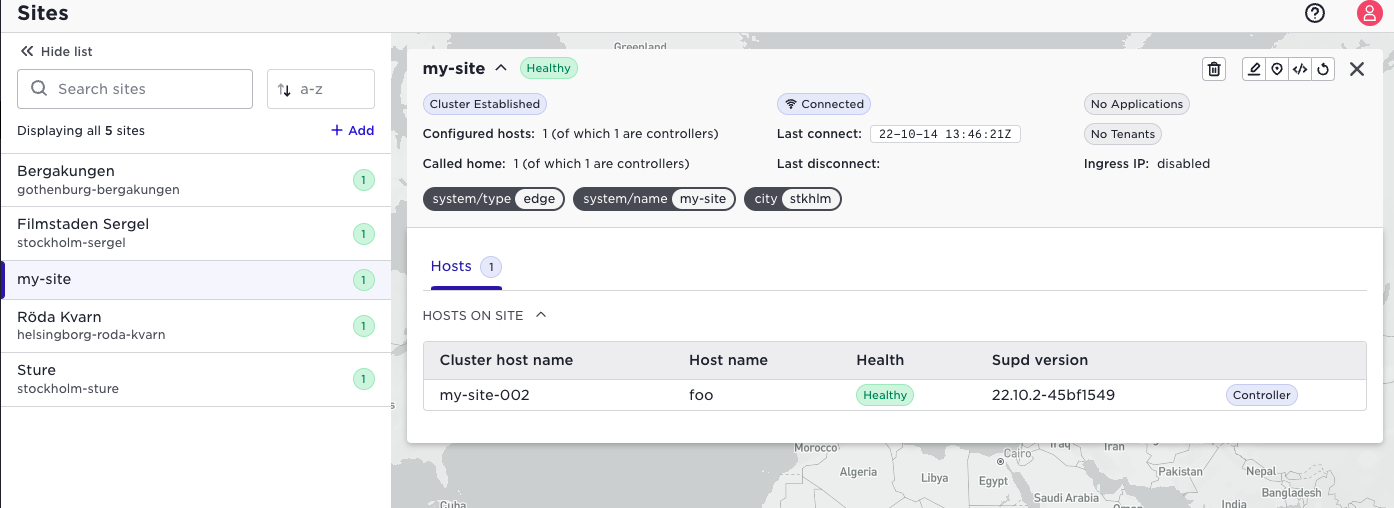Add a site
Introduction
A site is a collection of one or more hosts, virtual or physical, that typically reside in the same physical location. Each host has an edge enforcer installed.
The Avassa Control Tower and each host share a common secret, the
host-id. This is also how you configure which hosts belongs to the
same site. You can either configure (pre-provision) the site with its
hosts and host-ids before installing the hosts. Or you can run the
installation script on the hosts and later add them to the Control
Tower.
In this tutorial you will go through the following steps:
- Install Edge Enforcer
Use the installation script to install the Edge Enforcer and its dependencies.
- Create site configuration
Collect host IDs from each host and set these in the site configuration
For troubleshooting this procedure, see Site maintenance.
For sizing and requirements, see Host requirements and sizing.
Host changes made by the install script
The install script will install the following components:
- docker (or podman if invoked with
--podmanflag) - jq
- curl
- python3 (if supctl is installed)
- python3-websockets (if supctl is installed)
The Edge Enforcer can not be installed on a Ubuntu system with docker running in a snap. Please remove docker with sudo snap remove docker, the install script will automatically install docker.
All iptables rules are flushed, the Edge Enforcer configures the firewall using nftables.
Install the Edge Enforcer
The Edge Enforcer is a software agent that runs on each host that is to be managed by the Control Tower.
The Edge Enforcer is delivered as a container image (called supd) and is expected to run on a Docker or Podman container runtime with a set of privileges allowing it to run and monitor end-user containers.
If the host is registered in the Control Tower before the installation script is run, the Edge Enforcer can be downloaded immediately.
If the host is registered in the Control Tower after the installation script is run, all dependencies are installed and the systemd unit will periodically try to download the Edge Enforcer in the background.
Assuming your UI is at test.acme.avassa.net, the address below would be api.test.acme.avassa.net.
The exact command can be fetched in the UI, click the user icon in the top right corner, expand Resources and clock Install Edge Enforcer.

A dialog like this will show up.

The actual installation
curl -s https://api.test.acme.avassa.net/install | sudo sh
This will install the Edge Enforcer and all its prerequisites.
There are more options to the install script, please see
curl -s https://api.test.acme.avassa.net/install | sudo sh -s -- --help
Install Script for Avassa Edge Enforcer. Usage:
sudo ./install-supd [OPTIONS] ENVIRONMENT-ADDRESS
ENVIRONMENT-ADDRESS is the address of a Control Tower
Accepted OPTIONS are:
-i, --host-id HOST-ID When calling home use HOST-ID instead of the default
-y, --yes Do not prompt, assume 'yes' to all questions
-n, --dry-run Dry run mode, do not actually install anything
-s, --no-start Do not start supd after installation
-h, --help Show this help text and then exit
-c, --install-supctl Also install the supctl tool
--podman Install Podman (default: install Docker)
--no-userns-remap Do not enable user namespaces in daemon settings
--cert CERT When calling home use the supplied certificate
--install-prefix Install executables under this path instead of /usr
--preflight Run installation preflight checks
One of the following options emits the contents of the corresponding file
that would be installed, without running the installation:
--emit-start-supd Emit start-supd script
--emit-systemd-service Emit /etc/systemd/supd.service
--emit-openrc-service Emit /etc/init.d/supd
--emit-openrc-start-script Emit /usr/sbin/start-supd-openrc
--emit-uninstall-supd Emit uninstall-supd script
The following flag runs a standalone action without running the installation:
--get-host-id Emit the host-id as seen by supd
--uninstall Remove supd
Preflight installation checks
To run the preflight checks: curl -s https://api.test.acme.avassa.net/install | sudo sh -s -- --preflight.
This will output something like this:
Required Kernel Modules
-----------------------
All required kernel modules available
Recommended Kernel Modules
--------------------------
All recommended kernel modules available
Port Status
-----------
4646 Ok
4668 Ok
4848 Ok
51820 Ok
Control Tower Connectivity
--------------------------
Checking https://api.test.acme.avassa.net/healthz... Ok
Checking api.test.acme.avassa.net TCP port 443... Ok
Checking registry.test.acme.avassa.net TCP port 443... Ok
Checking test.acme.avassa.net TCP port 443... Ok
Checking volga.test.acme.avassa.net UDP port 443... Ok
Minimal Disk Requirements
-------------------------
Filesystem Avail
/dev/nvme0n1p2 369G
Make sure you have at least 500Mb of free disk where you install the Edge Enforcer
Minimal Memory Requirements
---------------------------
Total 131722756 kB of memory... Ok
Podman-based installation
By default the install script uses Docker as a container engine (the container
engine is installed if not present). If a Podman-based installation is desired,
then the install script should be invoked with --podman flag, e.g. as follows:
curl -s https://api.test.acme.avassa.net/install | sudo sh -s -- --podman
Note that the Avassa solution is not compatible with Podman older than Podman 4.0.0. This means some older distributions are not supported. Some of the minimum OS versions required for Podman-based installation are:
- Debian 12
- Ubuntu 22.04
- CentOS 9
- RHEL 9
Special case: requirement to use host networking
By default the installation script enables the user namespaces feature in
docker for increased isolation. However, when there is a requirement to
run services attached to the "host network" (host's default network namespace)
the user namespaces feature needs to be disabled due to a Docker limitation.
The best way to ensure that the user namespaces feature is disabled in Docker
configuration is to run the installation script with --no-userns-remap flag
as follows:
curl -s https://api.test.acme.avassa.net/install | sudo sh -s -- --no-userns-remap
This is only relevant for Docker-based installation.
Special case: manually assign host id
If you need to manually assign a host id during the installation you can pass that as a parameter:
curl -s https://api.test.acme.avassa.net/install | sudo sh -s -- --host-id <name>
Whenever you need to retrieve the host id you can do that with:
curl -s https://api.test.acme.avassa.net/scripts/get-host-id | sudo sh
This will output something like 7491b30f-655a-46cb-a947-0dfb3adc5c66.
supd.conf
The installation generates a supd.conf file in /etc/supd It
contains the host name and call home server. You can edit this file to
for example control IP overlay allocation or
if you need to assign some hosts as Control Tower proxies.
A default supd.conf example is shown below
host-id: "skehamn-host"
initial-site-config:
call-home-servers:
- api.test.acme.avassa.net
Whenever you edit the supd.conf file you need to restart supd to
apply the changes:
systemctl restart supd
Special case: configure a Control Tower proxy
If some or all hosts within an edge site are connected to a restricted network that lacks direct IP connectivity to the Control Tower, then such hosts can be configured to connect to the Control Tower via a proxy: another Edge Enforcer instance assigned to the same or another edge site that has direct IP connectivity to both the restricted network and the Control Tower. Please see the Control Tower proxy document for more info.
Configure the site in Control Tower
- UI
- Command Line
Select Sites in the left-hand menu and click +Add.

Give the site a name and optionally labels, location etc.

For each host, click the New host button and enter the host-id that was prompted by the corresponding install script on that host.

After adding all hosts, click to save the site.
The site will now be in a state where the site is not established and no host has called home:

Give the site a name and optionally labels, location etc.
supctl create system sites <<EOF
name: my-site
descriptive-name: Stockholm City Site
type: edge
location:
latitude: 59.34
longitude: 18.05
labels:
city: stockholm
topology:
parent-site: control-tower
ingress-allocation-method: disabled
hosts:
- host-id: 6e4d8db8-0833-4b5f-960d-a358d96aa1f2
EOF
Configure ingress IP allocation method for the new site
Ingress IP addresses is an important feature for the edge applications to be able to receive incoming traffic. In order for the ingress addresses to be reachable from outside the external network must be able to route the traffic to the relevant host in the edge site by the ingress IP address. The Avassa platform is not aware of the network configuration in the edge site, hence it is the responsibility of the site provider to indicate the relevant method the ingress IP addresses are allocated on an edge site.
By default the IP address allocation is disabled, and any application requesting an ingress address will fail to deploy. Should the edge applications be able to request ingress addresses one of the following methods needs to be configured:
- DHCP. With this method supd requests an ingress IP address from a DHCP server on behalf of the application. The DHCP server is not managed by the Avassa platform. It must support DHCP client identifier option and be reachable from any host in the edge site.
- configurable IP address pool (sitewide or per network interface per host). With this method the Avassa platform allocates the IP address from the pool, assuming that any address in the pool is routable from the outside network to the corresponding host interface.
- DHCP method with Command Line
- Sitewide ingress IP pool with Command Line
- Per interface ingress IP pool with Command Line
Indicate that the ingress IP should be allocated by making a DHCP request. It is assumed that the DHCP server is reachable from any host within the site. No additional configuration is required.
supctl merge system sites my-site <<EOF
ingress-allocation-method: dhcp
EOF
Configure the sitewide ingress IP allocation pool.
range indicates valid ingress IP addresses that can be allocated as ingress
IP addresses to applications on any host in the site. network-prefix-length
is used to identify the correct broadcast address for the network, it has no
relation to the size of the pool and should be set to the same value as the
network prefix lengh on the corresponding router interface as well as other
hosts in the same IP network.
supctl merge system sites my-site <<EOF
ingress-allocation-method: pool
ingress-ipv4-address-ranges:
- range: 192.0.2.128-192.0.2.254
network-prefix-length: 24
EOF
This method is appropriate when the ingress IP should be different depending on the host the application is scheduled to. There is even a possibility for the application to request an ingress address on a specific interface if such configuration is allowed by the site provider.
This method can be combined with the sitewide pool. In such case the sitewide pool is used for the hosts/interfaces that do not have a specific per interface pool configured. However, when a configured per interface pool is exhausted (no more IP addresses available for allocation), the sitewide pool is not used as a fall-back for this interface.
Having a single interface with host-interface-by-default-route: true selector
configured is equivalent to not having any interfaces configured. However, the
interface must be declared if there is a need to configure an interface-specific
ingress IP allocation pool.
range indicates valid ingress IP addresses that can be allocated as ingress
IP addresses to applications on any host in the site. network-prefix-length
is used to identify the correct broadcast address for the network, it has no
relation to the size of the pool and should be set to the same value as the
network prefix lengh on the corresponding router interface as well as other
hosts in the same IP network.
supctl merge system sites my-site <<EOF
ingress-allocation-method: pool
hosts:
- host-id: i-04ae7efa38fe361de
network-interfaces:
- name: default
host-interface-by-default-route: true
ingress-ipv4-address-ranges:
- range: 192.0.2.128-192.0.2.254
network-prefix-length: 24
EOF
Special case: specify intra site communication network
By default, the edge enforcers discovers the networks they are able to communicate on. In certain cases you may need to restrict this. You can whitelist networks by adding the following configuration to your site.
supctl merge system sites my-site <<EOF
cluster:
site-networks:
- 192.168.2.0/24
EOF
In the example above, all control traffic between the hosts on a site will go over the 192.168.2.0/24 network.
Make sure you update insecure-registries in /etc/docker/daemon.json to match the above network. This is only relevant for Docker-based installation.
Special case: allow local unseal
By enabling local unseal in the site, the site can unseal (decrypt) itself without network connection to the Control Tower. This will decrease security so make sure you understand the implications.
Site call home status
After a short while, the site should have called home, you can verify this by checking the state of the site and the host
- UI
- Command Line

To check the site has called home
supctl show system sites my-site
This will output something like this
name: my-site
type: edge
domain: avassa.net
labels:
system/type: edge
system/name: my-site
blocked: false
topology:
parent-site: control-tower
call-home:
state: initialized
hosts:
- host-id: i-04ae7efa38fe361de
call-home:
last-seen: 2021-11-24T11:19:46+00:00
reason: startup
supd-version: 0.1.0-65f0a7f9
cluster-hostname: my-site-001
smbios:
chassis-type: "1"
chassis-vendor: Xen
product-name: HVM domU
product-serial: ec20ff41-9e8f-c1f9-20d7-b9d4095ac956
product-uuid: ec20ff41-9e8f-c1f9-20d7-b9d4095ac956
product-version: 4.11.amazon
platform:
architecture: x86_64
total-memory: 990464 KB
vcpus: 1
operating-system: Arch Linux
kernel-version: 5.14.14-1-ec2
docker:
version: 20.10.10
api-version: "1.41"
os: linux
arch: amd64
git-commit: e2f740de44
components:
- name: Engine
version: 20.10.10
- name: containerd
version: v1.5.7
- name: runc
version: 1.0.2
- name: docker-init
version: 0.19.0
ingress-allocation-method: none
Inspect supd logs
By inspecting the Docker logs on the local host you can figure out the current state of the call-home process, and if the call-home sequence terminated successfully.
docker logs supd
You can also find valuable information by inspecting the systemd log files
journalctl -xu supd -f
Logs during call home with no response
The following example log entries below indicate that the call-home process is running, but is currently rejected by the Control Tower due to lack of matching configuration on the server side. This is the expected behaviour until the Control Tower has been configured to recognise the host-id.
docker logs supd
...
<NOTICE> 2021-04-06 12:08:00.311348+00:00 boot_callhome:82 UNKNOWN_CHOSTNAME <0.9.0>
reply from mothership 403 <<>> (retrying 264)
<NOTICE> 2021-04-06 12:08:10.344054+00:00 boot_callhome:82 UNKNOWN_CHOSTNAME <0.9.0>
reply from mothership 403 <<>> (retrying 263)
<NOTICE> 2021-04-06 12:08:20.382955+00:00 boot_callhome:82 UNKNOWN_CHOSTNAME <0.9.0>
reply from mothership 403 <<>> (retrying 262)
Logs after successful call home
After successfully calling home, a lot of logs on e.g. IP connectivity is printed. At the end you should see a System started log entry, this indicates the Edge Enforcer has successfully connected to the Control Tower, received its configuration and is ready to accept services.
<NOTICE> 2021-04-07 13:55:48.989500+00:00 dapid:47 sthlm-002 <0.1072.0>
dapid loaded and compiled routes
<NOTICE> 2021-04-07 13:55:48.990100+00:00 dapid_sup:27 sthlm-002 <0.1072.0>
starting http server on port 4646
<NOTICE> 2021-04-07 13:55:48.990287+00:00 dapid_sup:50 sthlm-002 <0.1072.0>
starting registry http server on port 4848
<NOTICE> 2021-04-07 13:55:49.008620+00:00 dapid_sup:77 sthlm-002 <0.1072.0>
starting docker_dc_net plugin http server on port 4949
<NOTICE> 2021-04-07 13:55:49.008719+00:00 dapid_sup:77 sthlm-002 <0.1072.0>
starting docker_gw_net plugin http server on port 4950
<NOTICE> 2021-04-07 13:55:49.013052+00:00 syst_server:110 sthlm-002 <0.940.0>
System started.
Host ID configuration
The host-id string that uniquely identifies the host to the call-home server (the Control Tower) for identification purposes. There are currently two ways to configure this value, either as a fixed string, or to configure supd to read a value from DMI.
- The fixed string approach requires you to manually edit the name of each host in its configuration file. This may become an issue if you plan on deploying many hosts.
- The DMI-approach uses the DMI/SMBIOS information in the
/sys/class/dmi/idvirtual filesystem to extract the product UUID of the local host computer and uses that as thehost-id. Notice that the string after theDMI:prefix represents the content of a file with that name in the filesystem.
For example, by specifying DMI: board_serial, the Edge Enforcer will read /sys/class/dmi/id/board_serial and report that value as the host-id.
By using the DMI approach you do not have to create unique configuration files for each host since the values are generated and unique.
Please Note: some hypervisors assign the same UUID to VMs which may result in host-id collisions. If using the DMI-approach, make sure the hosts get unique IDs and if that is not feasible, use the fixed-string approach.
Manual Installation
To manually install the Edge Enforcer, or to understand what the installation script does, please download it and open it up in your favourite editor. The script itself is well documented.
curl -O https://api.test.acme.avassa.net/install
Uninstall the Edge Enforcer
The first step is to delete the site in Control Tower, either in the UI or:
supctl delete system sites sthlm-5
Using the uninstall script
At a succeful installation of the Edge Enforcer, you can run
/var/lib/supd/state/bin/uninstall-supd
This will remove everything installed by the Edge Enforcer installer.
Manual uninstall
Stop the service
systemctl stop supd
Clean up the state and volume directories
umount -R /var/lib/supd/volumes
umount -R /var/lib/supd/state/secrets
umount -R /var/lib/supd/state/dhclient/_pid
rm -rf /var/lib/supd
Remove the service and configuration
rm /etc/systemd/system/supd.service
rm -rf /etc/supd/
Remove Avassa's docker images
docker images | awk '/avassa/ {print $1}' | xargs docker rmi -f